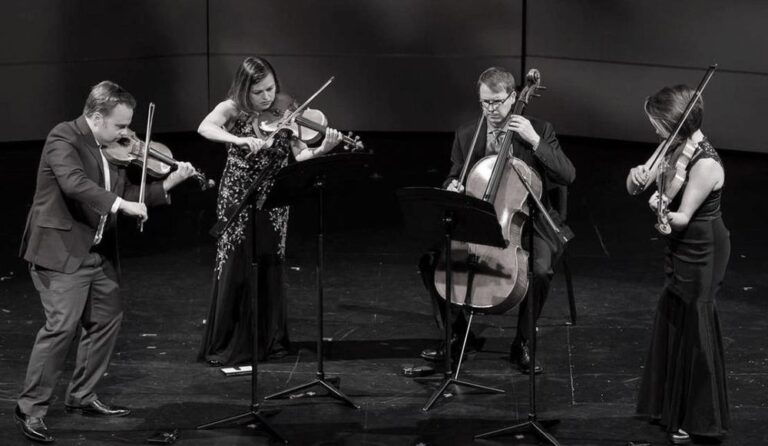Featuring veteran musicians and emerging talents, the 10-day long Dikishitar Beethoven Melharmony festival raises funds to assist musicians, the community who were the worst affected by the pandemic.
Fancy a Muthuswami Dikshitar kriti hobnobbing with a Beethoven Symphony? Unlikely? Melharmony Festival begs to disagree. For ten days in succession from December 26, 2020, works of the legendary composers, who happened to be contemporaries though they lived continents apart, came together on a single platform, Shaale. ‘Dikshitar – Beethoven Melharmony online Festival’, organised by Melharmony Foundation of which Chitravina artiste N Ravikiran is the artistic director, was an unprecedented effort to raise the fund called Musicians’ Covid Relief Fund (MCRF) to provide assistance to musicians, the community who were the worst affected by the pandemic. The help is to be provided on a case by case to thousands of artistes or their surviving families across the globe. Further, the help will go to artists irrespective of their genre, nationality or religion. The project also envisages collaborating with like-minded organisations with proven track records in this endeavour.
“Legendary artistes, ensembles as well as emerging ones have joined hands in empathy with their less fortunate colleagues and a large team has worked behind the scenes to make this a unique artistic experience”, says Ravikiran. “We are receiving great responses from the audience”, he added.

Since its inception, this is for the first time the festival is conducted online, courtesy Covid-19.
The festival, which includes 20 concerts, is still on for viewers across the globe until January 25.
“Every year, the festival addresses social issues such as climate change or environmental awareness,” says Vanitha Suresh, Director of Melharmony Foundation. This season, amid the anxieties of Covid-19 pandemic, the festival has been raising money for the musicians’ covid relief. “The pandemic has affected the artists, especially the performing musicians, very badly. Some died of the infection; a few unfortunately resorted to ending their lives due to economic distress,” says Suresh.
Dikshitar and Beethoven
From the musical point of view, the festival assumes much relevance as it is a celebration of the 250th birth anniversary of Ludwig van Beethoven and the 245th of his equally illustrious contemporary from India, Muthuswamy Dikshitar – two master composers who scaled the peaks of creativity in harmony and melody respectively of world music. Another happenstance is the 20th anniversary of Melharmony itself.
It may be difficult to believe that Dikshitar is the father of fusion music. A set of 39 compositions in Sanskrit all based on colonial tunes that came to India with British East India Company were written by him. They are known as nottuswaras. The beauty of these nottuswara sahitya lies in the fact that the introduction of Sanskrit lyrics into Western melodic themes has not resulted in something jarring or incongruous; on the other hand, these compositions are uniquely Indian, although devoid of the characteristic gamakas that decorate Indian melodic passages.
Technique of Melharmony
Harmonisation of ragas has been considered a well-nigh impossible task. But Melharmony seems to be the answer. Conceived by Ravikiran in 2000 it has been widely accepted as a revolutionary approach in world music. It explores chords and counterpoints anchored on melodic progression just as in Indian music. This is in sharp contrast to the traditional Western approach that is centred on harmonic progression.
To cite an example, Sankarabharanam has the same notes of the Western Major scale. But some of the chords that are conventionally employed in the Western compositions like its Tonic, Dominant and sub-Dominant or their inversions may not bring out the intrinsic melodic content of the raga which is latent in the gamakas centred on notes re, ma and dha. One will have to explore to find Diminished and even the Seventh chords that may bring out this essential quality of Indian music which is the sublimation of melody. Melharmony is thus the true combination of melody and harmony.
In the past years, the festival featured the works of German composer Johann Sebastian Bach and Carnatic composer Oothukadu Venkata Kavi, and Wolfgang Amadeus Mozart and Saint Thyagaraja.
Stalwarts and emerging talents
The concerts connect seasoned musicians with emerging talents, cutting across genres and geographies. The highlight of the festival was the confluence of Ravikiran, the four-time Grammy awardee GienVelez (Frame Drum), Loire Cotier (Rhythm Vocalist), K V Prasad (Mridangam), Apollo Chamber Players (Houston-based ensemble), David Connor (Vocalist), Ed Matthew (Clarinet), Ben Jaeger (Music teacher) and Steve Kurr (Music teacher) who collaborated on two compositions of Dikshitar and one of Beethoven. While the Dikshitar compositions were Sree Kantimathim in Hemavathi and Parvatipathe in Hamsadhwani, that of Beethoven was Snow Princess (Op.18, parts I and IV).
On the Indian side, the festival was also participated by Akkarai Sisters, Sikkil Gurucharan, Mylai Karthikeyan, R Surya Prakash, Neyveli Narayanan and, Vittal Rangan to mention a few in addition to a phalanx of vocalists and instrumentalists.
“We are so honoured to be part of this well-timed and important project aiming to support Covid relief while celebrating Ravikiran’s illustrious Melharmony”, say Glen Velez and Loire Cotler from New York.




